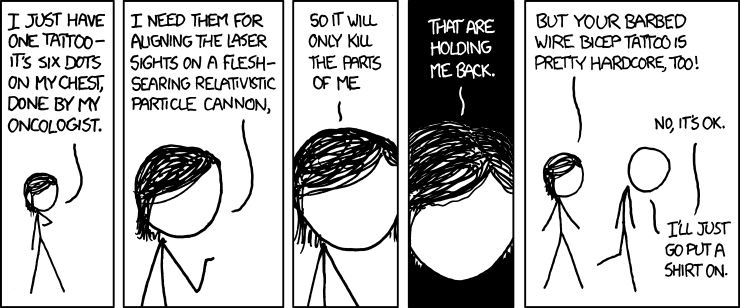I’ve made no secret of how brilliant I think Randall Munroe, author and artist of the webcomic XKCD, is (see “Randall Munroe and Zombie Marie Curie on Greatness,” “Off-topic: Does Wanting Something Make It Real?,” and “Some Common Misconceptions“). A few days ago, he offered a really, really good example of reframing. Reframing is looking at something in a different way, and when I talk about it on this site, I’m usually talking about looking at a situation in a more constructive way. Here’s Munroe’s comic, in which he offers a means of looking at cancer that in a weird way is almost joyful.
(Sorry for the shrinking: it’s a limitation of my blog’s design. You can click on the comic to see it full size on XKCD.)
There aren’t many perks I know of to being a cancer patient, but cancer patients go through experiences more harrowing than anything most of us have ever experienced. Coming through that kind of trouble without crumpling is a feat worth some serious respect, especially considering it’s more or less impossible to know for sure whether you’ve survived cancer or not (as Munroe explains in this comic).
It’s not unlike the massive outpouring of goodwill that greeted congresswoman Gabrielle Giffords when she appeared in Washington earlier in the week to vote on the debt ceiling bill (on which subject please don’t get me started). One not-very-politically-correct thought that crossed my mind is “does she like being applauded for getting shot in the head?” Fortunately I caught up after a minute or two and realized that it was not getting shot in the head she was getting applause for, but for months of struggle to get back to her job and for showing up at a vote despite enormous hardships. In the same way, cancer patients aren’t laudable for having cancer; they’re laudable when they show courage and perseverance in carrying on despite it.
We all get visited with trouble sometimes. We get fired, lose friends and family to illness or accident, have money troubles, have romantic troubles, get hurt … and none of that is really very encouraging to think about. It’s nothing to celebrate. Yet our responses to those situations when we persevere or overcome, even if we’re not doing anything particularly out of the ordinary, are definitely something to celebrate–and making celebration out of hardship can turn your whole outlook around.






